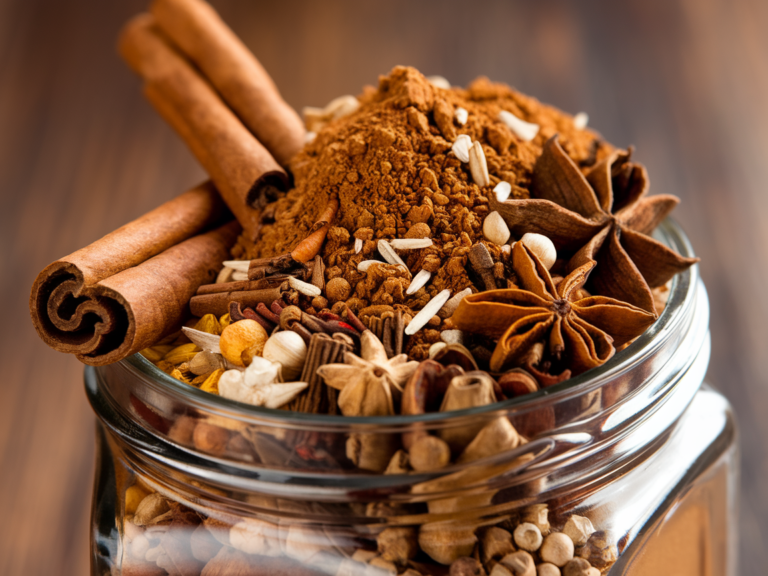As the autumn season approaches, so does the annual craze for pumpkin spice. From the iconic Pumpkin Spice Latte to baked goods and even home fragrances, pumpkin spice has become synonymous with fall. But a common question arises: Is pumpkin spice just cinnamon? While cinnamon plays a significant role, pumpkin spice is actually a blend of several spices, each contributing to the warm and comforting flavor we associate with the season. In this article, we’ll explore what pumpkin spice is, how it’s used, and why it’s more than just cinnamon.
What is Pumpkin Spice Made Of?
Contrary to popular belief, pumpkin spice is not just cinnamon. Instead, it’s a blend of spices that work together to create the rich, aromatic flavor that complements pumpkin-based dishes and more. Here’s a breakdown of the common ingredients found in pumpkin spice:
- Cinnamon: The primary spice in the blend, known for its sweet and warm flavor.
- Nutmeg: Adds a slightly nutty and sweet taste with a hint of earthiness.
- Ginger: Brings a subtle spiciness that balances the sweetness of the other spices.
- Cloves: Offers a deep, rich aroma that adds complexity to the blend.
- Allspice (optional): Sometimes included for additional warmth and a hint of peppery flavor.
Each of these spices plays an essential role in creating the layered flavor that defines pumpkin spice. For those who enjoy the comforting flavors of fall, this spice blend is essential for both sweet and savory dishes. If you’re interested in making your own pumpkin spice blend, this guide on How to Make Pumpkin Spice at Home offers a simple recipe you can customize to your taste.
The Role of Cinnamon in Pumpkin Spice
While pumpkin spice is more than just cinnamon, there’s no denying that cinnamon is the star of the show. Here’s why:
- Primary Flavor: As the main spice in the blend, cinnamon provides warmth and sweetness, making it instantly recognizable in any dish that includes pumpkin spice.
- Enhances Other Spices: Cinnamon pairs well with nutmeg, ginger, and cloves, balancing the spicier notes while adding depth to the blend.
However, not all cinnamon is the same. There are two main types: Ceylon cinnamon and Cassia cinnamon. Ceylon cinnamon, also known as “true cinnamon,” has a milder and sweeter flavor, while Cassia cinnamon is more commonly used and has a stronger, spicier taste. Either type can be used in pumpkin spice, depending on your flavor preference.
How Pumpkin Spice is Used in Cooking and Baking
Pumpkin spice is beloved for its versatility in the kitchen. Whether you’re making classic desserts or experimenting with new savory dishes, this spice blend can elevate your cooking. Here are some common ways to use pumpkin spice:
- Sweet Dishes: The most popular use of pumpkin spice is in sweet treats, such as pumpkin pies, muffins, and cookies. The warmth of cinnamon combined with the nuttiness of nutmeg and the spiciness of ginger makes these desserts comforting and delicious.
- Beverages: Pumpkin spice is perhaps most famous for its use in beverages like the Pumpkin Spice Latte. It’s also used in hot chocolate, teas, and even smoothies to add a touch of fall flavor.
- Savory Dishes: While less common, pumpkin spice can also be used in savory dishes. It pairs well with roasted vegetables, particularly pumpkin, squash, and sweet potatoes. The blend of spices adds warmth and depth to these dishes, making them perfect for fall meals.
For a great fall treat, try pairing your favorite pumpkin spice beverage with these Earl Grey Cookies for a unique and aromatic twist.
Health Benefits of Pumpkin Spice
In addition to its delicious flavor, pumpkin spice offers several health benefits thanks to the individual spices in the blend. Here’s a look at the health properties of each:
- Cinnamon: Known for its antioxidant and anti-inflammatory properties, cinnamon can help regulate blood sugar and improve heart health. Research suggests that cinnamon may also help lower cholesterol levels and fight infections. For more detailed information, check out the Health Benefits of Cinnamon.
- Nutmeg: Rich in antioxidants, nutmeg is known for its ability to support digestion and improve sleep quality. It also has anti-inflammatory properties and may help reduce symptoms of arthritis.
- Ginger: Often used for its anti-nausea and digestion-supporting effects, ginger also has anti-inflammatory benefits. It’s a common remedy for soothing an upset stomach and boosting the immune system.
- Cloves: These tiny spice buds are packed with antioxidants and are known for their ability to promote liver health and improve blood circulation. Cloves are also commonly used in oral health remedies due to their antibacterial properties.
By incorporating pumpkin spice into your cooking, you’re not only enhancing the flavor of your meals but also adding a range of health benefits. 
Common Misconceptions About Pumpkin Spice
Despite its popularity, there are a few misconceptions about pumpkin spice that are worth clarifying:
- Pumpkin Spice Does Not Contain Pumpkin: Despite its name, pumpkin spice doesn’t include any actual pumpkin. Instead, it’s a blend of spices traditionally used to flavor pumpkin-based dishes like pumpkin pie.
- Pumpkin Spice vs. Pumpkin Pie Spice: The terms pumpkin spice and pumpkin pie spice are often used interchangeably, but they refer to the same blend of spices. Whether it’s called one or the other, the key ingredients—cinnamon, nutmeg, ginger, and cloves—remain the same.
- Is Pumpkin Spice Just Cinnamon?: While cinnamon is the dominant spice in the blend, pumpkin spice is far more complex, incorporating other warm spices like nutmeg and ginger. Without these additional spices, the blend wouldn’t have the same depth of flavor that makes it so versatile.
The History of Pumpkin Spice
The history of pumpkin spice dates back to traditional American baking, where it was commonly used in pumpkin pies and other fall desserts. However, it wasn’t until Starbucks introduced the Pumpkin Spice Latte (PSL) in 2003 that the blend became a cultural phenomenon. Since then, pumpkin spice has expanded far beyond its culinary roots, appearing in everything from scented candles to skincare products.
For a more traditional fall treat to enjoy alongside your pumpkin spice latte, try the rich and decadent Pioneer Woman’s Ultimate Hello Brownie.
FAQs – Pumpkin Spice and Cinnamon
- Is pumpkin spice mostly cinnamon?
Yes, cinnamon is the primary ingredient in pumpkin spice, but it’s complemented by other spices like nutmeg, ginger, and cloves to create a more complex flavor. - Can I make pumpkin spice without cinnamon?
While possible, leaving out cinnamon would significantly alter the flavor, as it’s the spice that gives pumpkin spice its signature warmth. - What’s the difference between pumpkin spice and cinnamon?
Pumpkin spice is a blend of multiple spices, with cinnamon being one of them. Cinnamon, on the other hand, is a single spice used in a wide variety of recipes. - Does pumpkin spice taste like pumpkin?
No, pumpkin spice tastes like the spices traditionally used in pumpkin dishes, not like pumpkin itself. - How can I make homemade pumpkin spice?
You can easily make your own blend by mixing cinnamon, nutmeg, ginger, and cloves in the proportions you prefer. Follow this simple Pumpkin Spice Mix Recipe to customize your own spice blend at home.
Conclusion
So, is pumpkin spice just cinnamon? While cinnamon is a key player, it’s the combination of other spices like nutmeg, ginger, and cloves that truly defines pumpkin spice. Together, these spices create a flavor that’s warm, comforting, and perfect for fall. Whether you’re making a classic pumpkin pie or experimenting with savory dishes, pumpkin spice is a versatile and essential blend for the season. For those who enjoy customizing their spice blends, making your own pumpkin spice mix can add a personal touch to your favorite recipes.
Print
Is pumpkin spice just cinnamon?
As the autumn season approaches, so does the annual craze for pumpkin spice. From the iconic Pumpkin Spice Latte to baked goods and even home fragrances, pumpkin spice has become synonymous with fall. But a common question arises: Is pumpkin spice just cinnamon? While cinnamon plays a significant role, pumpkin spice is actually a blend of several spices, each contributing to the warm and comforting flavor we associate with the season. In this article, we’ll explore what pumpkin spice is, how it’s used, and why it’s more than just cinnamon.
- Total Time: 5 minutes
- Yield: ¼ cup of spice mix 1x
Ingredients
- 3 tablespoons ground cinnamon
- 2 teaspoons ground ginger
- 2 teaspoons ground nutmeg
- 1 ½ teaspoons ground cloves
- 1 teaspoon ground allspice (optional)
Instructions
- Combine Spices
In a small bowl, mix together ground cinnamon, ground ginger, ground nutmeg, ground cloves, and ground allspice (if using). - Store the Mix
Transfer the mixture to an airtight container and store in a cool, dry place. This spice mix can last up to six months. - Use as Needed
Add to your favorite fall recipes, including pumpkin pie, lattes, cookies, and more!
- Prep Time: 5 minutes
- Cook Time: 0 minutes (no cooking required)
- Category: Spice Blend
- Method: Mixing
- Cuisine: American
- Diet: Vegan
Keywords: pumpkin spice mix, homemade pumpkin spice, cinnamon spice mix, fall spices, pumpkin pie spice, spice blend for fall, DIY pumpkin spice, gluten-free spice blend, fall baking




